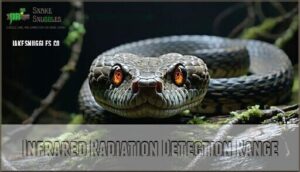This site is supported by our readers. We may earn a commission, at no cost to you, if you purchase through links.
 You’ll find pit viper heat sensing organs anatomy fascinating – these specialized structures are nature’s thermal imaging system.
You’ll find pit viper heat sensing organs anatomy fascinating – these specialized structures are nature’s thermal imaging system.
The pit organs sit between each eye and nostril, featuring a thin membrane stretched across a deep cavity.
This membrane contains thousands of heat-sensitive nerve endings that detect infrared radiation from warm-blooded prey.
When a mouse scurries by, temperature changes on the membrane trigger neural signals to the brain’s trigeminal nucleus.
The air-filled chamber behind the membrane acts like a biological thermostat, amplifying even tiny temperature differences.
This setup lets pit vipers "see" heat signatures in complete darkness, making them deadly nocturnal hunters.
But there’s more to this thermal detection system than meets the eye.
Table Of Contents
- Key Takeaways
- Pit Viper Heat Organs
- Pit Organ Membrane Structure
- Infrared Detection Mechanism
- Pit Organ Functionality
- Ecological Role of Pit Organs
- Frequently Asked Questions (FAQs)
- What is the heat sensing organ in a pit viper?
- What organ does a snake use to sense heat?
- What do pit vipers have to detect heat?
- Where are pit organs located in pit vipers?
- What do pit vipers sense with their pit organs?
- What sensory organ do viper snakes have?
- What organ helps snakes sense heat?
- How do pit vipers use heat detection?
- How do pit vipers behave in cold environments?
- Can pit vipers regulate their own temperature?
- Conclusion
Key Takeaways
- You’ll find pit organs located between each eye and nostril, containing ultra-thin membranes packed with thousands of heat-sensitive nerve endings that can detect temperature changes as small as 0.003°C.
- You’re looking at nature’s thermal imaging system – these organs convert infrared radiation from warm-blooded prey into electrical signals that travel through trigeminal nerves to your brain’s processing centers.
- You can think of this as biological radar that works in complete darkness, allowing pit vipers to detect prey up to 40 centimeters away by sensing their body heat signatures.
- You’ll notice the dual pit organ setup creates stereoscopic thermal vision, letting these snakes triangulate prey location and distance with deadly precision for nocturnal hunting.
Pit Viper Heat Organs
You can find these specialized heat-sensing organs between each eye and nostril, forming distinctive facial pits that give pit vipers their name.
These loreal pit organs house an incredibly thin membrane packed with temperature-sensitive nerve endings that can detect heat differences as small as 0.003°C, making them highly sensitive to their surroundings with temperature-sensitive capabilities.
Location of Pit Organs Between Eyes and Nostrils
You’ll spot these remarkable heat sensors nestled between each eye and nostril on pit vipers’ faces.
These specialized facial anatomy features give these snakes their name and superior infrared sensing capabilities compared to other serpents.
Key Features of Pit Organ Placement:
- Bilateral symmetry – One loreal pit organ on each side provides stereo thermal imaging for precise triangulation
- Strategic positioning – Located midway between nostril and eye to avoid interference with snake vision systems
- Prominent cavity size – Each viper heat pit measures 1-5mm wide, several times larger than nostril diameter
- Protected exposure – Deep cavity placement shields the heat sensing organs while maximizing thermal detection
- Distinctive identification – This unique pit organ structure differentiates pit vipers from boas and pythons with smaller labial pits
The heat sensing organs in pit vipers utilize thermal detection mechanisms to locate prey in complete darkness.
Structure of The Pit Organ Membrane
Positioned like a drumhead, the pit organ membrane stretches across each facial cavity with remarkable thinness.
This delicate structure contains thousands of heat sensors packed with nerve endings that respond to infrared radiation.
**Nature’s biological radar system transforms tiny temperature changes into a deadly hunting advantage.
The membrane’s specialized design maximizes thermal detection capabilities through its unique composition and positioning.
| Membrane Component | Function |
|---|---|
| Thin tissue layer | Rapid heat transfer |
| Dense nerve endings | Temperature signal detection |
| Vascular networks | Quick cooling response |
| Ion channels | Electrical signal generation |
The membrane structure enables pit vipers to detect temperature changes as small as 0.003°C, making it one of nature’s most sensitive thermal detectors for hunting prey.
Neural Connections to The Brain
Once the pit organ membrane detects temperature changes, specialized nerve fibers from the trigeminal branch somatosensory system carry these brain signals through dedicated neural pathways.
These nerve impulses travel via precise synapse function to reach the brain’s sensory integration centers.
Your pit viper’s neural image processing transforms thermal data into actionable hunting information, making snake infrared detection incredibly effective through viper heat pits and sophisticated pit viper anatomy.
Comparison With Other Snake Sensory Organs
Most snakes rely on multiple sensory systems for survival, but pit vipers possess a unique advantage through their specialized thermal imaging abilities.
While Snake Vision helps many species hunt, pit vipers combine infrared receptors with traditional senses.
Their loreal pit organs detect temperature changes other snakes can’t perceive, creating sophisticated thermal sensing organs.
This Comparative Anatomy showcases remarkable Sensory Evolution – pit viper anatomy integrates multiple snake sensory organs for superior prey detection compared to species lacking these thermal capabilities.
The poor spatial resolution of pit vipers is related to their thermal imaging limitations that affect their hunting accuracy in complete darkness.
Evolutionary Adaptations of Pit Organ Anatomy
Three independent evolutionary events produced infrared detection in snakes, demonstrating remarkable Adaptive Radiation.
You’ll find pit vipers evolved the most sophisticated system through Pit Organ Evolution, developing suspended membranes in loreal pit organs that create precise thermal images.
Their TRPA1 channels underwent molecular refinements, lowering thermal thresholds to 28°C for enhanced Infrared Detection capabilities in Snake Vision systems.
Pit Organ Membrane Structure
The pit organ’s membrane works like a biological thermometer made of ultra-thin tissue packed with specialized nerve endings.
You’ll find this remarkable structure suspended inside each facial cavity, connected to dense blood vessels that help it detect temperature changes as small as 0.003°C, which is a very specialized feature.
Thin Membrane Composition
The heat sensing pit contains a remarkably thin membrane that’s only a few micrometers thick – thinner than tissue paper.
This delicate membrane materials structure includes specialized cellular components designed for maximum thermal sensitivity.
The membrane’s unique cellular structure allows rapid temperature detection through densely packed infrared receptors.
These labial pit organs in pit vipers contain membranes with specific ion channels that respond instantly to thermal changes, making the heat sensing pit incredibly effective for detecting warm-blooded prey in darkness.
The pit vipers’ ability to detect heat is due to their advanced infrared sensing capabilities, which include maximum thermal sensitivity and rapid temperature detection through densely packed receptors, allowing them to detect warm-blooded prey.
Heat-Sensitive Nerve Endings
Within the thin membrane’s framework, specialized nerve endings act as your snake’s thermal antenna system.
These TRPA1 channels and thermosensors convert heat into electrical signals with remarkable precision. The heat receptors respond to temperature changes as small as 0.003°C, creating a sophisticated infrared detection network.
The snakes’ ability to detect heat is similar to advanced infrared sensor technology used in various applications.
- Nerve Ending Structure: Dense clusters of heat-sensitive fibers from trigeminal nerves
- Thermal Sensitivity: TRPA1 channels activate when temperature shifts occur
- Heat Detection: Infrared receptors respond to 5-20 micrometer wavelength radiation
- Neural Signaling: TRP channels generate electrical impulses for brain processing
Vascularized and Innervated Membrane
You’ll find the pit viper’s membrane structure relies heavily on dense vascular networks and innervation patterns.
Blood vessels rapidly cool the vascularized, innervated membrane after thermal sensing events, maintaining peak sensitivity.
These infrared receptors work like a biological reset button – the rich blood supply quickly returns nerve endings to baseline temperature.
This vascular cooling system lets pit vipers create sharp thermal images of prey moving through their environment, utilizing their unique infrared receptors.
Muscle-Controlled Ducts for Air Pressure
Your pit viper’s loreal pit organ needs perfect Air Pressure balance to detect infrared receptors effectively.
Muscle Control systems operate specialized ducts that regulate pressure on both sides of the sensing membrane. This Pressure Balance prevents membrane distortion that would compromise the pit organ system’s sensitivity.
Here’s how Duct Mechanics work in facial pit function:
- Pressure equalization – muscles open/close ducts automatically
- Membrane stability – prevents warping during temperature detection
- Sensitivity maintenance – keeps infrared receptors at peak performance
- Environmental adaptation – adjusts to altitude and weather changes
- Response optimization – guarantees rapid prey detection capability
Infrared Detection Mechanism
You’ll discover how pit vipers transform infrared radiation into electrical signals that their brains can interpret.
This remarkable process begins when heat from warm-blooded prey strikes the thin membrane inside each pit organ, triggering a cascade of molecular events that creates a thermal "image" of the snake’s surroundings, which can be considered a thermal "image".
Infrared Radiation Detection Process
When you encounter a warm object, your pit viper’s membrane absorbs infrared radiation like a biological antenna.
This infrared radiation detection triggers thermal imaging through specialized TRPA1 channels that convert heat detection into electrical signals.
Your snake’s thermal sensing system processes radiation patterns from wavelengths between 750 nanometers to 1 millimeter.
This infrared sensing mechanism enables precise signal processing for effective prey location.
The ability to detect infrared radiation relies on advanced infrared detectors technology that enhances thermal vision capabilities.
Temperature Change Sensitivity on Pit Organ Membrane
Your pit viper’s membrane responds to temperature changes as small as 0.003°C, making it incredibly sensitive to thermal variations.
This thermal sensitivity enables precise heat detection through three key mechanisms:
- Membrane Response – The thin tissue reacts instantly to infrared radiation
- Temperature Resolution – Distinguishes minute thermal differences between objects
- Infrared Reception – Captures heat signatures from warm-blooded prey
This thermal perception system gives pit vipers unmatched thermal sensing capabilities for hunting.
Signal Transduction From Membrane to Nerve Cells
Once you detect those temperature changes, your pit viper’s membrane signals begin converting thermal information into electrical messages.
TRPA1 channels within thermosensors respond to heat variations by opening, allowing ions to flow across cell membranes.
This creates nerve impulses that travel through signal pathways to your snake’s brain, and the neural coding process transforms thermal detection into interpretable data, giving pit vipers their remarkable thermal perception in snakes abilities, which is based on thermal information.
Neural Impulse Generation and Transmission
Electrical signals spark when heat-activated TRPA1 channels open along the trigeminal branch.
You’re witnessing nature’s thermal telegraph system – action potentials race from the membrane to your brain’s processing center.
These nerve impulses create synaptic transmission pathways, transforming thermal stimuli into a neural thermal image that guides your strike with deadly precision.
Pit Organ Functionality
You’ve now discovered how pit vipers detect infrared radiation, but understanding their functional capabilities reveals the true power of this sensory system.
These remarkable organs don’t just sense heat—they create a thermal map that guides precise hunting behaviors even in complete darkness.
Infrared Radiation Detection Range
Your infrared sensing system operates within specific thermal limits, detecting heat signatures from prey up to 40 centimeters away.
The detection threshold responds to temperature differences as small as 0.003°C, giving you remarkable thermal imaging capabilities.
This infrared range covers radiation spectrum wavelengths between 5-20 micrometers, allowing effective thermal detection in complete darkness for successful hunting.
Spatial Resolution Limitations of Pit Organs
You’ll find that pit viper thermal imaging isn’t like your smartphone camera.
These facial pit organs can’t resolve spatial details smaller than 9 degrees, creating blurry heat maps rather than sharp images.
The wide pit aperture maximizes heat detection sensitivity but sacrifices spatial awareness.
This infrared sensing limitation means distinguishing closely-spaced prey becomes nearly impossible, establishing clear sensory boundaries for these remarkable predators.
Ability to Detect Prey in Low-light Conditions
You’ll witness nature’s most sophisticated nighttime predation system in action.
Pit vipers excel at low light hunting through specialized infrared sensing capabilities that function independently of ambient lighting conditions.
Their heat sensing organs detect warm-blooded prey up to 40 centimeters away in complete darkness within half a second.
This thermal imaging system transforms invisible infrared radiation into precise prey localization data, making these snakes formidable nighttime predators.
The snakes’ ability to detect heat is based on their infrared sensing capabilities.
Triangulation of Prey Direction and Distance
You can think of pit vipers as living thermal cameras with built-in rangefinders. Their dual pit organs create a three-dimensional thermal map through Directional Sensing and Distance Calculation.
Key triangulation abilities:
- Prey Tracking through binocular thermal imaging comparison
- Spatial Awareness using temperature gradient analysis
- Thermal Imaging angle measurements for precise location
- Snake Thermal Vision combining both pit organs for accurate Infrared Detection
This Pit Viper system works like your ears localizing sound—but with heat signatures instead. The snakes’ ability to detect heat is related to advanced thermal imaging techniques.
Temperature Contrast Sensitivity and Prey Detection
You’ll discover that pit vipers detect temperature contrasts as small as 0.003°C through their specialized thermal imaging system.
Their heat detection capabilities enable precise prey localization even when animals blend with ambient temperatures.
Temperature gradients create distinct thermal signatures that these snakes’ infrared sensing organs translate into actionable hunting data.
| Detection Capability | Temperature Range | Prey Distance |
|---|---|---|
| Minimum contrast | 0.003°C difference | Up to 40cm |
| Preferred sensing | 5-20 µm infrared | 15-30cm range |
| Maximum detection | Body heat variance | 1 meter away |
Ecological Role of Pit Organs
You’ll discover that pit organs transform pit vipers into nature’s most efficient nocturnal hunters, giving them a decisive edge in environments where vision fails.
These thermal sensors create complex ecological relationships that reshape predator-prey dynamics and drive evolutionary adaptations across entire ecosystems.
Predatory Advantages in Various Environments
When darkness falls, you’ll find pit vipers excel across diverse habitats through sophisticated thermal sensing abilities.
Their infrared detection provides unmatched hunting strategies in forests, deserts, and grasslands.
Environmental adaptation allows precise prey localization regardless of lighting conditions.
This thermal imaging capability enhances predatory performance, giving these snakes survival tactics that outcompete purely visual hunters in challenging environments.
The pit vipers’ heat sensing capabilities rely on advanced infrared detection systems to locate warm-blooded prey.
Prey Adaptations to Avoid Pit Viper Detection
Prey species have developed clever Camouflage Strategies and Thermal Regulation techniques to outsmart pit viper infrared detection.
You’ll find animals adjusting their Prey Behavior by selecting complex thermal backgrounds that mask their heat signatures from thermal sensing.
Evasion Techniques include:
- Freezing motionless against cool surfaces to minimize thermal contrast
- Seeking dense vegetation where body heat blends with environmental temperatures
- Timing activity during cooler periods when thermal perception becomes less effective
Interspecies Competition and Niche Exploitation
You’ll often find pit vipers using Competition Strategies that create distinct Niche Partitioning among snake species.
Their thermal sensing and infrared detection capabilities provide an Adaptive Advantage in nocturnal hunting, establishing unique ecological niches.
This specialized heat sensing organs anatomy allows different species to exploit separate Predator Prey relationships, maintaining Ecological Balance by reducing direct competition for resources.
Evolutionary Pressures on Pit Viper Sensory Systems
Through environmental pressures, pit viper thermal sensing systems underwent remarkable evolutionary refinement.
Selective advantages of infrared detection drove multiple independent origins across snake lineages, creating specialized ecological niches.
These evolutionary tradeoffs balanced sensory precision against metabolic costs, enabling predator-prey dynamics in diverse habitats.
Thermal adaptation through enhanced TRPA1 channels and refined pit organ anatomy demonstrates how evolutionary pressures shaped these sophisticated sensory systems for maximum survival, highlighting the importance of evolutionary refinement.
Frequently Asked Questions (FAQs)
What is the heat sensing organ in a pit viper?
You’ll find the loreal pit organ between each nostril and eye on a pit viper’s face.
This specialized heat-sensing chamber contains a thin membrane packed with nerve endings that detects infrared radiation from warm-blooded prey.
What organ does a snake use to sense heat?
Snakes use specialized pit organs to detect heat.
You’ll find these remarkable sensors located between the eyes and nostrils on pit vipers.
They’re hollow chambers with ultra-sensitive membranes that detect temperature changes as small as 003°C, letting snakes "see" warm-blooded prey in complete darkness.
What do pit vipers have to detect heat?
Like a thermal camera built into nature, you’ll find pit vipers equipped with specialized loreal pit organs between their eyes and nostrils.
They detect infrared radiation with incredible precision, sensing temperature differences as small as 003°C, which is a unique feature that highlights their specialized abilities.
Where are pit organs located in pit vipers?
You’ll discover pit organs positioned between each nostril and eye on either side of a pit viper’s face.
These specialized heat-detecting chambers sit strategically near the snake’s visual system, creating perfectly positioned thermal sensors for hunting prey.
What do pit vipers sense with their pit organs?
You’re wondering whether these specialized sensors truly create thermal "vision"?
Pit vipers detect infrared radiation through heat-sensitive membranes in their pit organs.
These biological thermometers sense temperature differences as tiny as 003°C, letting you locate warm-blooded prey in complete darkness.
What sensory organ do viper snakes have?
You’ll find pit vipers equipped with specialized loreal pit organs—heat-detecting chambers located between their eyes and nostrils that sense infrared radiation from warm-blooded prey.
What organ helps snakes sense heat?
Pit vipers detect temperature changes as small as 003°C using specialized pit organs—hollow facial cavities lined with heat-sensitive membranes that convert thermal radiation into electrical signals for your brain.
How do pit vipers use heat detection?
You’ll track warm-blooded prey in complete darkness using specialized pit organs that detect infrared radiation. These facial sensors convert temperature differences into electrical signals, creating thermal "images" for hunting.
How do pit vipers behave in cold environments?
In cold environments, you’ll find them hibernating during winter months by seeking rocky crevices or underground burrows for protection.
They’ll go dormant when temperatures drop too low for activity, sometimes gathering in huge numbers to share a winter den.
Can pit vipers regulate their own temperature?
Surprisingly, you’d be wrong assuming reptiles can’t warm themselves.
Pit vipers are ectothermic, meaning they can’t generate internal heat like you can.
Instead, they regulate temperature through behavioral thermoregulation – basking in sunlight, seeking shade, or burrowing underground.
Conclusion
Knowledge is power, but for pit vipers, thermal knowledge means survival.
You’ve explored how pit viper heat sensing organs anatomy creates nature’s most sophisticated thermal detection system.
These specialized organs transform infrared radiation into precise neural signals, letting snakes hunt warm-blooded prey in complete darkness.
The thin membrane’s heat-sensitive nerve endings work with air-filled chambers to detect temperature changes as small as 0.003°C.
This remarkable adaptation gives pit vipers their deadly hunting edge when darkness falls.

















